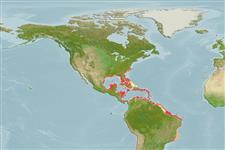Common names from other countries
Environment: milieu / climate zone / depth range / distribution range
экология
морской ассоциированный с рифами; пределы глубины 0 - 30 m (Ref. 9626). Tropical; 45°N - 8°N, 99°W - 58°W (Ref. 55370)
Western Atlantic: Florida, USA to Brazil. Larvae are sometimes swept northward which accounts for the sighting of juvenile specimens as far north as Massachusetts, USA during summer months. One record (one specimen, 3 cm) from Musquodoboit Harbor, Nova Scotia, Canada.
Length at first maturity / Size / Вес / Возраст
Maturity: Lm 13.9 range ? - ? cm
Max length : 20.0 cm TL самец/пол неопределен; (Ref. 7251)
колючие лучи спинного плавника (общее число) : 12 - 14; членистые (мягкие) лучи спинного плавника (общее число) : 18 - 21; колючие лучи анального плавника: 3; членистые (мягкие) лучи анального плавника: 15 - 17. Body is white with a black bar running across the head through the eye. In juveniles, a second black bar runs from the base of the soft portion of the dorsal fin to the base of the anal fin. The dorsal, caudal and anal fins are either yellow or transparent (Ref. 4855). A narrow yellow bar from gill opening to pectoral base (Ref. 13442).
Inhabit shallow, coral reefs with clear water (Ref. 9626). Develop dusky bands at night. Generally common (Ref. 9710). Oviparous (Ref. 205). Form pairs during breeding (Ref. 205).
Life cycle and mating behavior
Maturities | размножение | Spawnings | Egg(s) | Fecundities | личинки
Form pairs during breeding (Ref. 205).
Randall, J.E., 1996. Caribbean reef fishes. Third Edition - revised and enlarged. T.F.H. Publications, Inc. Ltd., Hong Kong. 3nd ed. 368 p. (Ref. 13442)
Статус Красного Списка МСОП (Ref. 130435)
CITES (Ref. 128078)
Not Evaluated
Угроза для людей
Harmless
Использование человеком
рыболовство: коммерческий; аквариум: коммерческий
дополнительная информация
инструменты
Специальные отчеты
Скачать в формате XML
ресурсы в Интернет
Estimates based on models
Preferred temperature (Ref.
115969): 23.9 - 28.2, mean 27.2 (based on 612 cells).
Phylogenetic diversity index (Ref.
82804): PD
50 = 0.5000 [Uniqueness, from 0.5 = low to 2.0 = high].
Bayesian length-weight: a=0.02570 (0.01537 - 0.04300), b=3.02 (2.88 - 3.16), in cm Total Length, based on LWR estimates for this species & Genus-body shape (Ref.
93245).
Trophic level (Ref.
69278): 3.7 ±0.2 se; based on diet studies.
устойчивость к внешним воздействиям (Ref.
120179): высокий, минимальное время удвоения популяции до 15 месяцев (Preliminary K or Fecundity.).
Fishing Vulnerability (Ref.
59153): Low vulnerability (10 of 100).
